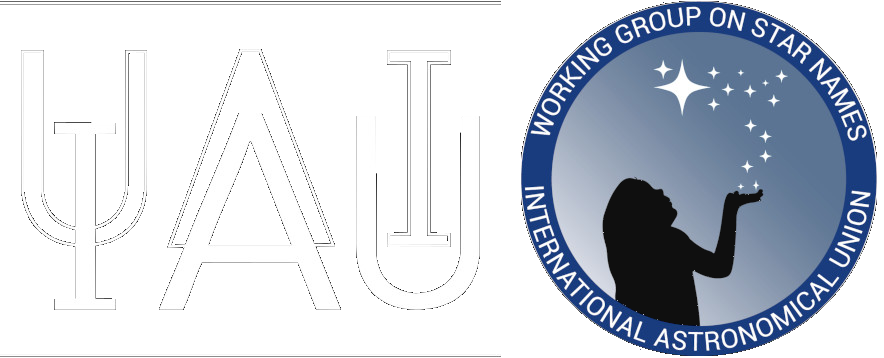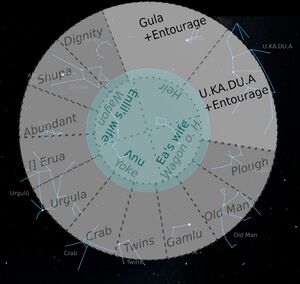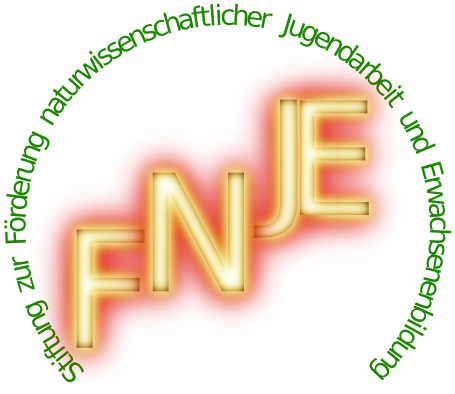Ekur
The Ekur (E2-kur) is an ancient Mesopotamian super-constellation consisting of the group of the Standing Gods of the Ekur (mulDIĜIR.GUB.BAmeš) and the Sitting Gods of the Ekur (mulDIĜIR.TUŠ.Ameš), both mentioned in MUL.APIN.
Dictionary (Provenance of the term)
Krebernik (2023)
see glossary of Hoffmann and Krebernik (2023):[1]
mulDIĜIR.GUB.BAmeš & mulDIĜIR.TUŠ.Ameš. The sumerograms are ambiguous, since the first sign can be read as DIĜIR “god” or AN “heaven”, and TUŠ can also be read DÚR (both meaning “to sit”) or KU. However, the addition of A makes the reading TUŠ virtually certain. In the same manner, BA confirms the reading of GUB.BA. The Sum. forms mean “seated, sitting” and “standing”, respectively.
The corresponding entries in the dictionaries are angubbû (AHw, CAD) and ankurû (CAD), antušû (AHw), respectively. The first sumerogram, which is much more common than the second, designates a type of priest and describes the function of certain (minor) deities in god lists. In the OB Ištar ritual from Mari, the DIĜIRmeš DIĜIR-gub-bu-ú are obviously (representations of) deities, who “sit down to the left of Ištar together with (the god) Latarak” (ii 1’-3’, see Ziegler 1997, 58). The usage in MUL.APIN, where the two expressions are connected with Enlil’s temple Ekur in Nippur (“The stars of the Standing/Sitting Gods of the Ekur”) seems to be comparable. In 5R 46: 15–16., the “Standing Gods of the Ekur” are interpreted as “Sîn and Nergal”, and the “Sitting Gods” as “Anu and Enlil”, which is not applicable to MUL.APIN. The same is true of [M]UL.DIĜIR.GUB].BAmeš DIĜIR.TUŠ.Ameš in Hg, where they are identified with Sîn and Šamaš (MSL 11, 41: 52). MUL.DIĜIR.GUB.BAmeš šu-ut É.KUR / MUL.DIĜIR.TUŠ.Ameš šu-ut É.KUR (after EN 21).
Hoffmann and Krebernik Text Edition
The path of Enlil in MUL.APIN[1]
| our numbering | DIŠ | explanandum | explanans |
|---|---|---|---|
| 1 | 1 | STAREPINNU (Plough) | GODEnlil |
| 2 | 1 | STARBARBARU (Wolf) | seeder of STAREPINNU |
| 3 | 1 | STARŠĪBU (Old Man) | GODEnmešarra |
| 4 | <1> | STARGAMLU (Throwing-stick) | GODGamlum(Throwing-stick) |
| 5–6 | 1 | STARTŪ’AMŪ·RABÛTU (Great Twins) | GODLugalirra and GODMeslamtaʾea |
| 7–8 | 1 | STARTŪ’AMŪ·ṢEḪRŪTU (Little Twins) | GODAlammuš and GODNingublaga |
| 9 | 1 | STARALLUTTU (Crab) | seat of GODAnu |
| 10 | 1 | STARURGULÛ (Lion) | GODLatarak |
| 11 | 1 | STAR opposite STARURGULÛ | STAR (of the) King |
| 12 | 1 | twinkling STARs in the tail of STARURGULÛ | ‘date-palm spadix’ (jewellery?) (of) GODErua | GODZarpanītum |
| 13 | 1 | STARŠU.PA (The Bright?) | GODEnlil who determines the destinies of the land |
| 14 | 1 | STAR in front of it: STARḪENGALLĀYU (Abundant) | vizier of GODNinlil |
| 15 | 1 | STAR behind it: STARBĀŠTUM(Dignity) | vizier of GODTišpak(<*INANNA!?) |
| 16 | 1 | STAREREQQU (Wagon) | GODNinlil |
| 17 | 1 | STAR by the pole of STAREREQQU: STARŠĒLEBU(Fox) | GODErra, the strong of the gods |
| 18 | 1 | STAR on the forehead of STAREREQQU: STARLAḪRU(Ewe) | GODAya |
| 19 | 1 | STARMU.BU.KÉŠ.DA (Hitched yoke?) | GODAnu-rabû of heaven |
| 20 | 1 | STARMAR.GÍD.DA.AN.NA (Wagon of heaven) | GODDamkianna |
| 21 | 1 | STAR in its bond: STARAPIL-EMAḪ (Heir of the Emaḫ-temple) | foremost son of GODAnu |
| {1} | STAR·STANDING·GODs of the Ekur | The stars (of the) Standing Gods of the Ekur | |
| ({1}) | STAR·SITTING·GODs of the Ekur | Sitting Gods of the Ekur (temple) | |
| 22 | 1 | STARENZU (She-Goat) | GODGula |
| 23 | 1 | STAR in front of STARENZU | STARKALBU(Dog) (of GODGula) |
| 24 | 1 | bright STAR of STARENZU | GODLamassatu | vizier of GODBaba (= GODGu-la) |
| 25–26 | 1 | 2 STARs behind it | GODNin-SAR and GODErrakal |
| 27 | 1 | STARU4.KA.DU8.A | GODU.GUR(Nergal) |
| 28 | 1 | STAR to the right of it | STARŠAḪÛ(Pig) | GODDamu |
| 29 | 1 | STAR to the left of it | STARSSISÛ(Horse) |
| 30 | 1 | STAR behind it | STARLULIMMU | vizier of STAR.STAR (Pleiades) |
| 31 | 1 | twinkling STARs opposite STARLULIMMU(Stag) | GODḪarriru (Field Mouse) | GODManzât(Rainbow) |
| 32 | 1 | red bright STAR in the kidney of STARLULIMMU | STARPĀŠITTU (Deleter) |
| When the STARs of GODEnlil are completed: | |||
The Standing Gods and the Sitting Gods are rubric markers (like headlines in modern texts). Then, the rest of the list can be rendered as itemized lists in modern text layout.[2]
| explanandum | explanans | |
|---|---|---|
| Standing Gods of the Ekur |
|
|
| Sitting Gods of the Ekur |
|
|
| Outside the Ekur |
|
|
Kurtik with Hilder, Hoffmann, Horowitz, Kim
| Sources | Identifications |
|---|---|
MUL.APIN.
| |
MUL.APIN.
|
additional
Deities of the Ekur
- Standing Gods
- Enlil
- Enmešarra
- Lugalirra and Meslamtaʾea
- Alammuš and Ningublaga
- Anu
- Latarak
- Erua | Zarpanītum
- Enlil
- Sitting Gods
- Tišpak
- Ninlil and her vizier
- Erra
- Aya
- Anu
- Damkianna
- The Heir of the Emaḫ-temple (could be Enlil's or Anu's son)
Historical Dictionaries
The historical dictionaries by Kurtik (2007) and Gössmann (1950) both don't include this term, as the discovery of the astronomical unit of The Ekur only happened in a series of papers later (Hoffmann and Krebernik 2023,[1] Hoffmann and Horowitz 2023,[3] and Hoffmann 2024[2])
References
- ↑ 1.0 1.1 1.2 Hoffmann, S. M. and Krebernik, M. (2023). What do deities tell us about the celestial positioning system, in: R. Rollinger, I. Madreiter, M. Lang, C. Pappi (eds.). The Intellectual Heritage of the Ancient Near East, Papers held at the 64th Rencontre Assyriologique International and 12th Melammu Symposium July 16-20 2018, Innsbruck. Austrian Academy of Sciences Press, 539-579
- ↑ 2.0 2.1 Hoffmann, S.M. (2024): Standing and Sitting Gods of MUL.APIN, Journal of Astronomical History and Heritage, 27(2), 261-272
- ↑ Hoffmann and Horowitz (2023). The Standing and Sitting Asterisms of Ekur, N.A.B.U., n°3 (sept.), 141-143






